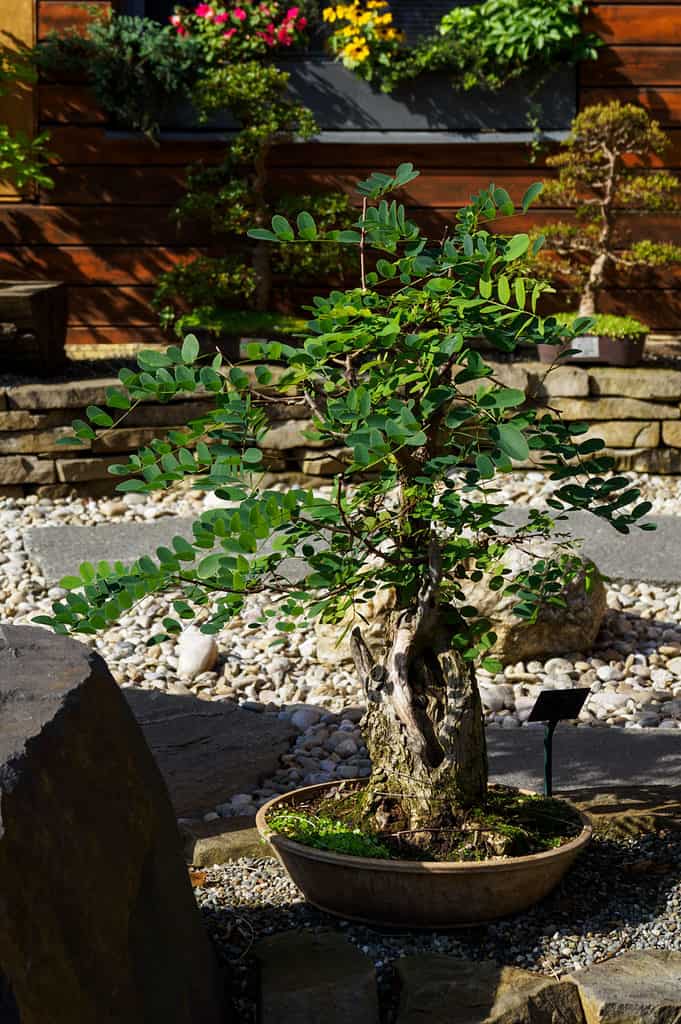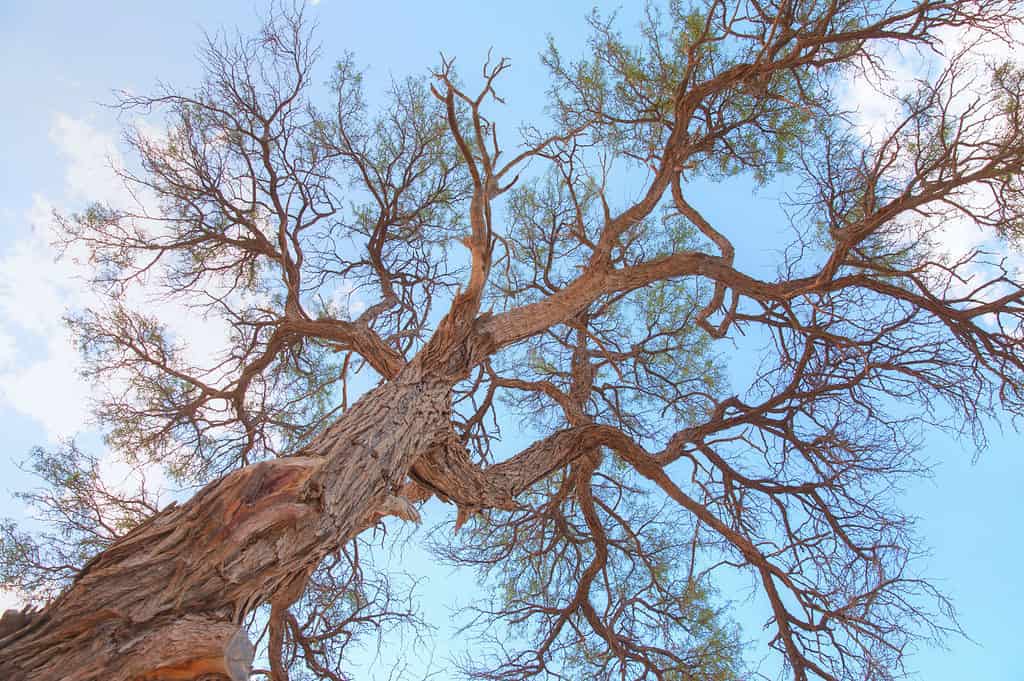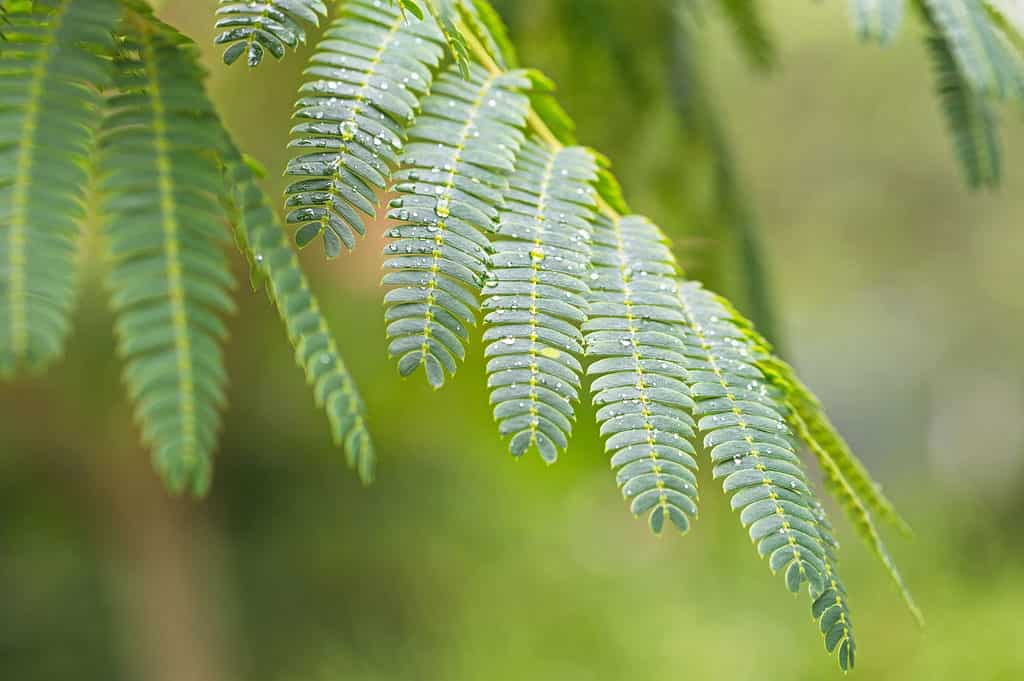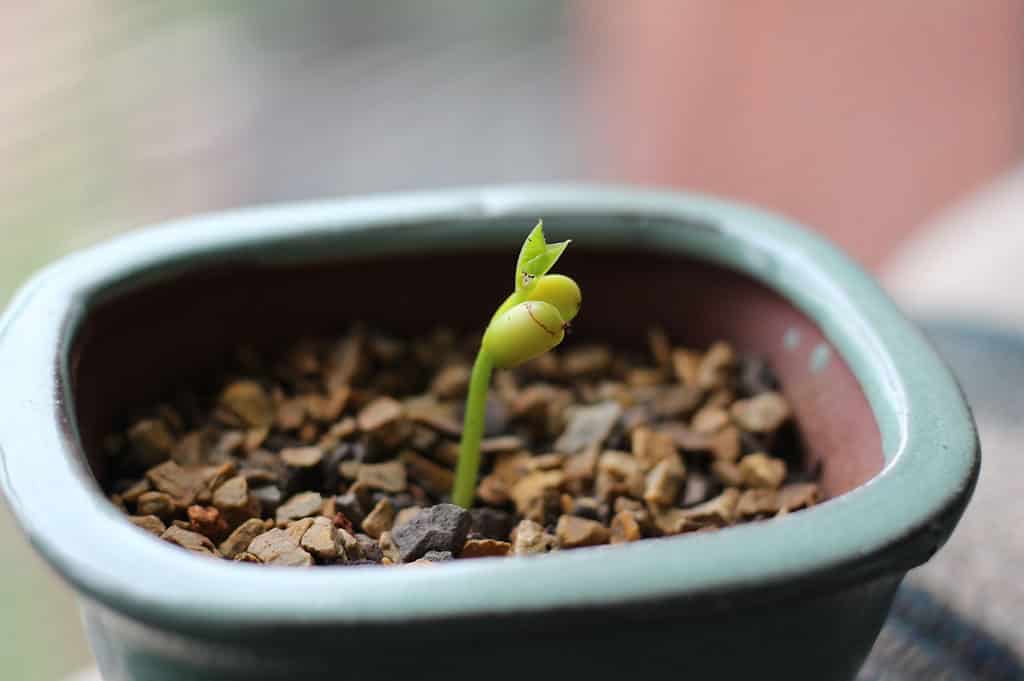Acacia Bonsai trees are definitely some of the most beautiful Bonsai trees out there. The acacia tree’s natural appearance makes for some striking Bonsai art. The challenge of growing and styling an acacia Bonsai tree is also worth the payoff. But what are the most common types of acacia trees used for Bonsai? What do you need to know about to care for one of these trees?
Whether this is your first journey into the world of Bonsai, or you are simply curious, here is everything you need to know about caring for an acacia Bonsai tree!

It can be difficult to get the temperatures right for an acacia Bonsai tree.
©Lapis2380/Shutterstock.com
| Acacia Bonsai Tree Facts | |
|---|---|
| Botanical Name | Acacia |
| Common Types | Cootamundra wattle, silver wattle, sweet acacia, Pineland acacia, Mudgee wattle, twisted acacia, Wright acacia |
| Sunlight | Full to partial sunlight, four to six hours a day |
| Soil | Acidic or alkaline |
| Water | Well-draining; keep the rootball moist but be careful not to overwater |
| For Beginners? | Intermediate to Advanced |
| Indoors or Outdoors? | Outdoors in warm, airy climates but indoors if it is too hot or too cold |
| Pairs Well With… | Rocks and moss, other natural ornamentation |
Common Types of Acacia Bonsai Trees

Full-size acacia trees should give you some indication of how your acacia Bonsai tree will look.
©muratart/Shutterstock.com
Acacia trees, also known as wattle trees, make up a massive genus of over 1,200 trees. They can be found all over the world. Most of these trees make perfect Bonsai trees. But not every acacia tree has the same appearance or care requirements.
Cootamundra Wattle
The Cootamundra wattle is native to Australia. It is a fast-growing, evergreen tree. In the late winter to early spring, it blooms bright yellow flowers. These flowers are fluffy and round. The Cootamundra wattle prefers full sun and should be pruned as soon as it begins to flower.
Silver Wattle
The silver wattle is native to Tasmania, Australia. It is a fast-growing, evergreen tree. In the late winter to early spring, it blooms bright yellow flowers. These flowers are round and fluffy. The silver wattle prefers full sun in soil that is neutral or acidic. It should be pruned immediately after it begins to flower.
Sweet Acacia
Sweet acacia trees are native to the southern United States, on through Mexico, Central America, and South America. They are fast-growing, up to 24 to 36 inches every year, and stay green year-round. These trees bloom fluffy yellow flowers in the late winter to early spring that are known for their fragrance. Sweet acacia trees thrive in both full sun and partial shade. They prefer loose soil that isn’t too wet. Once established, these trees are resistant to insects and other pests.
Pineland Acacia
Pineland acacia trees are native to southern Florida. They are evergreen trees and grow slower than their other acacia cousins. In the late spring to early summer they bloom yellow or orange colored flowers that are known for their sweet fragrance. Pineland acacia trees prefer full sun and can even thrive in soil that is poor in nutrients.
Mudgee Wattle
The Mudgee wattle tree is native to Australia. It is an evergreen tree that blooms fluffy yellow flowers in the late winter to early spring. These flowers are known for their fragrance. These trees thrive in both full sun and partial shade. They can grow in just about any type of soil, from well-draining soil to clay to acidic and everything in between.
Twisted Acacia
The twisted acacia tree is native throughout southern Texas and northern Mexico. In the spring, it blooms ball-like flowers that are yellow to orange in color. These trees grow at a moderate pace and do best in full sun. They can tolerate many different soil types as well.
Wright Acacia
The Wright acacia tree is native to Texas. Out of all the acacia trees native to Texas, the Wright Acacia is the hardiest when it comes to cold temperatures. It is an evergreen tree that blooms flowers in the springtime. These flowers are a white-yellow color. Wright acacia trees prefer full sun and do best in alkaline soil. Once established, they are resistant to pests, insects, and diseases.
Caring for Your Acacia Bonsai Tree

Some acacia species are better suited to Bonsai tree development than others.
©Modest Things/Shutterstock.com
Growing an acacia Bonsai tree can be a bit more difficult than growing other Bonsai trees. This is because acacia trees have specific care requirements. Some of these care requirements differ from tree variety to tree variety. It is important to know which acacia variety you have or are interested in caring for so that it can grow well.
With this in mind, here are some tips for growing an acacia Bonsai tree.
Sunlight
As a whole, the sunlight requirements for an acacia Bonsai tree depend on exactly what type of acacia tree you have. For the most part, acacia trees prefer full sun to partial shade. Acacia trees that require full sun will need to be beneath the sun for six hours a day. Acacia trees that require partial shade need to be placed in an area that is shaded for roughly half of the day.
These trees are used to airy environments that are not too hot nor too cold. Because of this, you’ll want to make sure to keep your acacia bonsai tree away from the hot afternoon sun and to bring it indoors when temperatures dip below 40 degrees Fahrenheit.
Soil Type
Different acacia trees prefer different soil types, so make sure you are aware of which acacia tree you have. For the most part, they prefer well-draining soil and can tolerate different kinds of soil and soil conditions.
Bonsai trees, however, require special soil mixtures in order to grow correctly. You can purchase these soil mixtures pre-made or you can mix your own. Generally, most Bonsai soil mixtures are made up of organic soil matter, pumice, Akadama, and lava rock. And since acacia trees produce their own nitrogen, you don’t have to worry about using a fertilizer with nitrogen in it!
Water
Watering a Bonsai tree can be tricky at times. If possible, you’ll want to avoid hard water. Specifically with acacia trees, you’ll want to keep the rootball moist so that it doesn’t dry out all the way. However, you don’t want to overwater it. Some acacia trees prefer soil that is dryer, while others can tolerate more moist soil. Again, make sure you are aware of what acacia tree you have so you can check out what it needs.
Placement
Placing a Bonsai tree can help or hinder the growth of your tree, depending on what kind of light and air your Bonsai tree needs.
Acacia trees are used to warm, airy climates though some are hardier than others when it comes to cold, heat, and drought. If you plan on keeping your acacia Bonsai tree outside, make sure to monitor temperatures. Bring it inside or place it in a heated greenhouse to avoid cold winter weather, as the leaves can wither.
Pruning Your Acacia Bonsai Tree

Acacia Bonsai tree leaves may need to be trained smaller.
©nnattalli/Shutterstock.com
Pruning can be one of the most challenging aspects of growing a Bonsai tree. Different types of Bonsai trees need to be pruned at different times and in different ways. Because of this, it is important to know when and how to prune your tree!
Acacia Bonsai trees are known to grow quickly, so you’ll have to prune them regularly for them to keep their shape. In the spring and summer months, you can prune branches back, leaving only a small number of leaves. When winter comes around, it is best to do the most pruning then.
Ideal Acacia Bonsai Tree Styles
One of the most popular styles of Bonsai for acacia trees is the Yose-ue style, which is also known as the forest Bonsai style. Acacia trees are also suited to the Kabudachi style. Since most acacia trees grow upright, it can be difficult to prune and guide them into any Bonsai style. But that doesn’t mean it isn’t impossible! It is easier to style acacia trees when they are younger, as the branches are more pliable.
Propagating Your Acacia Bonsai Tree

You can grow your acacia Bonsai tree from seed.
©Chante Chantelle/Shutterstock.com
Unfortunately, it can be a bit difficult to propagate an acacia Bonsai tree. It can be done, though, with enough skill, care, and patience!
You can propagate an acacia Bonsai tree from the cuttings or seeds of other acacia trees. Sometimes, the propagated seeds from an acacia tree won’t grow without scarification. This can be done by opening, nicking, breaking, or otherwise weakening the seed.
Common Problems with Acacia Bonsai Trees
Fortunately, there aren’t many problems with acacia Bonsai trees! Some types are more prone to pests, insects, and diseases than others but for the most part, acacia trees are relatively resistant to pests and diseases. However, when an acacia Bonsai tree is weakened, it can fall prey to aphids and other such insects. And, as with most other plants, root rot can become an issue if the tree is watered too much or too often.
The photo featured at the top of this post is © nnattalli/Shutterstock.com
Thank you for reading! Have some feedback for us? Contact the AZ Animals editorial team.






